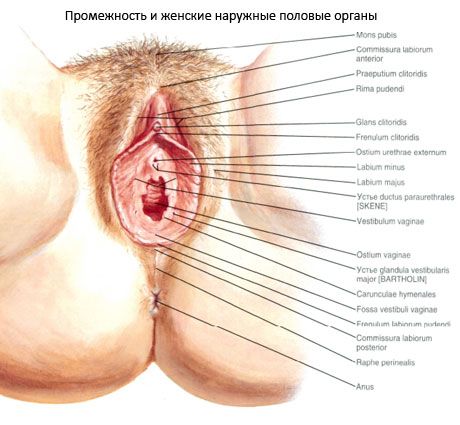Vagina
Last reviewed: 27.11.2021

All iLive content is medically reviewed or fact checked to ensure as much factual accuracy as possible.
We have strict sourcing guidelines and only link to reputable media sites, academic research institutions and, whenever possible, medically peer reviewed studies. Note that the numbers in parentheses ([1], [2], etc.) are clickable links to these studies.
If you feel that any of our content is inaccurate, out-of-date, or otherwise questionable, please select it and press Ctrl + Enter.
The vagina (vagina, s.colpos) - an unpaired hollow organ shaped like a tube, is located in the cavity of the small pelvis and extends from the uterus to the genital gaps. At the bottom of the vagina passes through the urogenital diaphragm.
The length of the vagina is 8-10 cm, the wall thickness is about 3 mm. The vagina is somewhat curved posteriorly, its longitudinal axis with the uterine axis forming an obtuse angle (somewhat greater than 90 °) open anteriorly. The upper end of the vagina starts from the cervix, goes down, where the lower end opens in the vestibule with the opening of the vagina. In girls, the vaginal opening is closed by the hymen (hymen), the attachment point of which delimits the vestibule from the vagina. The hymen is a semilunar or perforated connective tissue plate. During the first sexual intercourse, the hymen ruptures and its remnants form the hymen of the hymen (carunculae hymenales). In the collapsed condition, the lumen of the vagina on the cross-section is a front-slit (cavity).
The vagina has a front wall (paries anterior), which in the upper third lies at the bottom of the bladder, and in the rest of the site is fused with the wall of the female urethra. The posterior wall (paries posterior) of the vagina in its upper part is covered with the peritoneum of the rectum and uterine cavity, and the lower part of the wall is attached to the anterior wall of the rectum. The walls of the upper part of the vagina, enclosing the vaginal part of the cervix, form around it a narrow slit - the vaginal fornix (fornix vaginae). Due to the fact that the posterior wall of the vagina is longer than the anterior, and above is attached to the cervix, the posterior part of the vault (pars posterior) is deeper than the front part (pars anterior).

The structure of the walls of the vagina
The wall of the vagina consists of three membranes. The outer adventitial tunica (tunica adventitia) is constructed from a loose connective tissue containing a considerable amount of elastic fibers, as well as bundles of smooth (undistorted) muscle cells. The middle muscularis (tunica muscularis) is represented mainly by longitudinally oriented bundles of muscle cells, as well as by beams having a circular direction. Above the muscular membrane of the vaginal wall passes into the musculature of the uterus, the bottom becomes more powerful and its bundles are weaved into the muscles of the perineum. The bundles of striated muscle fibers, covering the lower end of the vagina and simultaneously the urethra, form a kind of muscular pulp.
The inner membrane of the vaginal wall is represented by the mucosa (tunica mucosa). Due to the absence of a submucosa, it directly fuses with the muscular membrane. The surface of the mucous membrane is covered with multilayered flat epithelium; glandular mucosa does not contain. The mucous membrane is rather thick (about 2 mm). Epithelial cells of its surface layer contain a significant amount of glycogen. The structure and thickness of the epithelium depend on the phase of the ovarian-menstrual cycle. By the time of ovulation due to increased estrogen secretion, the glycogen content in epithelial cells is increasing. Glycogen is used to maintain the normal functioning of spermatozoa. The conversion of glycogen to lactic acid provides an acid reaction in the vagina. The mucous membrane forms numerous transverse folds - vaginal folds (rugae vaginale) or wrinkles. On the anterior and posterior walls of the vagina, closer to the median line, the folds become higher, form longitudinally oriented folds of folds (columnae rugarum). Located on the front wall of the vagina anterior column of folds (columna rugarum anterior) is expressed better than on the back wall. Below it is a longitudinally oriented protrusion - the urethral carina of the vagina (carina urethritis vaginae) corresponding to the passing urethra. The posterior column of the folds (columna rugarum posterior) is located to the right or to the left of the anterior, so that the collapsed vagina does not overlap the anterior and posterior columns. The basis of the columns of folds is the mucosa, which is thicker here than elsewhere, and contains bundles of smooth muscle cells and numerous veins. In connection with this, the columns of folds on the section have a spongy structure.
Vessels and nerves of the vagina
The vaginal blood supply is carried out by the branches of the internal iliac artery: the vaginal artery, which is the descending branch of the uterine artery and supplies mainly its upper part; the lower pemphigus artery, supplying the blood to the middle section of the vagina; the middle rectus intestinal artery; the internal sexual artery providing nutrition to the lower part of the vagina; posterior branches of labia.
The lymph outflow from the vaginal area occurs: from the lower third of it to the superficial and deep inguinal lymph nodes, from the upper two thirds to all three major groups of the pelvic lymph nodes -the iliac, internal iliac and sacral.
Innervation of the vagina is carried out mainly by branches departing from the general uterine-vaginal plexus. From the inferior sections of this plexus, the vaginal nerves leave, providing sympathetic and parasympathetic innervation.
The vagina receives a sensitive innervation due to the branches of the sacral plexus.

